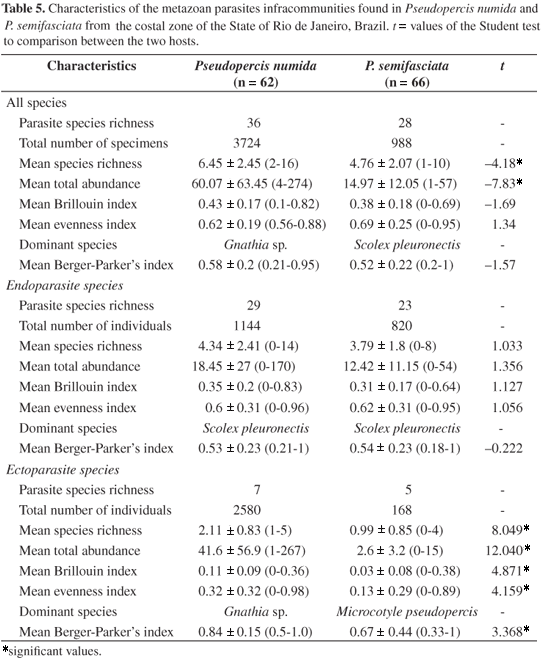One hundred and twenty-eight specimens of namorado sandperches, 62 P. numida and 66 P. semifasciata, collected between October 2002 and June 2003 off the Cabo Frio, Rio de Janeiro, Brazil (Lat 23° S and Long 42° W), were examined to study their metazoan parasites. Parasite communities of these fish were composed basically of endoparasites, mainly digenean and cestodes species, with low prevalence and abundance but having high parasite species richness values (at the component community level). Among these values, that found for P. numida is the highest so far recorded for marine fishes from the Neotropical Region. Thirty-nine species of metazoan parasites were collected: 36 from P. numida and 28 from P. semifasciata. Twenty-five parasite species were common to both species of namorado sandperches. Pseudopercis numida and P. semifasciata are new host records for all parasite species collected, with the exception of Microcotyle pseudopercis. Choanodera sp., Leurodera decora, Neolebouria georgenascimentoi, and Proctoeces sp. which were recorded for the first time in the South American Atlantic Ocean. Gnathia sp. from P. numida and Scolex pleuronectis from P. semifasciata were the species having the greatest dominance frequency. Parasite abundance in P. numida and P. semifasciata were positively correlated with the host total length. Only in P. numida was parasite species richness correlated positively with the host total length. No significant differences between endoparasite infracommunities of P. numida and P. semifasciata were detected. The ectoparasites of P. numida had higher values for parasite abundance, parasite richness, Brillouin index, evenness index, and Berger-Parker index than those of the ectoparasites of P. semifasciata. Comparisons among all ecto- and endoparasites showed the ectoparasites of P. numida as the most heterogeneous group. Low similarity values were observed among the three types of parasite infracommunities of the two hosts.
parasite ecology; community structure; marine fish; Pinguipedidae; Pseudopercis; Brazil







